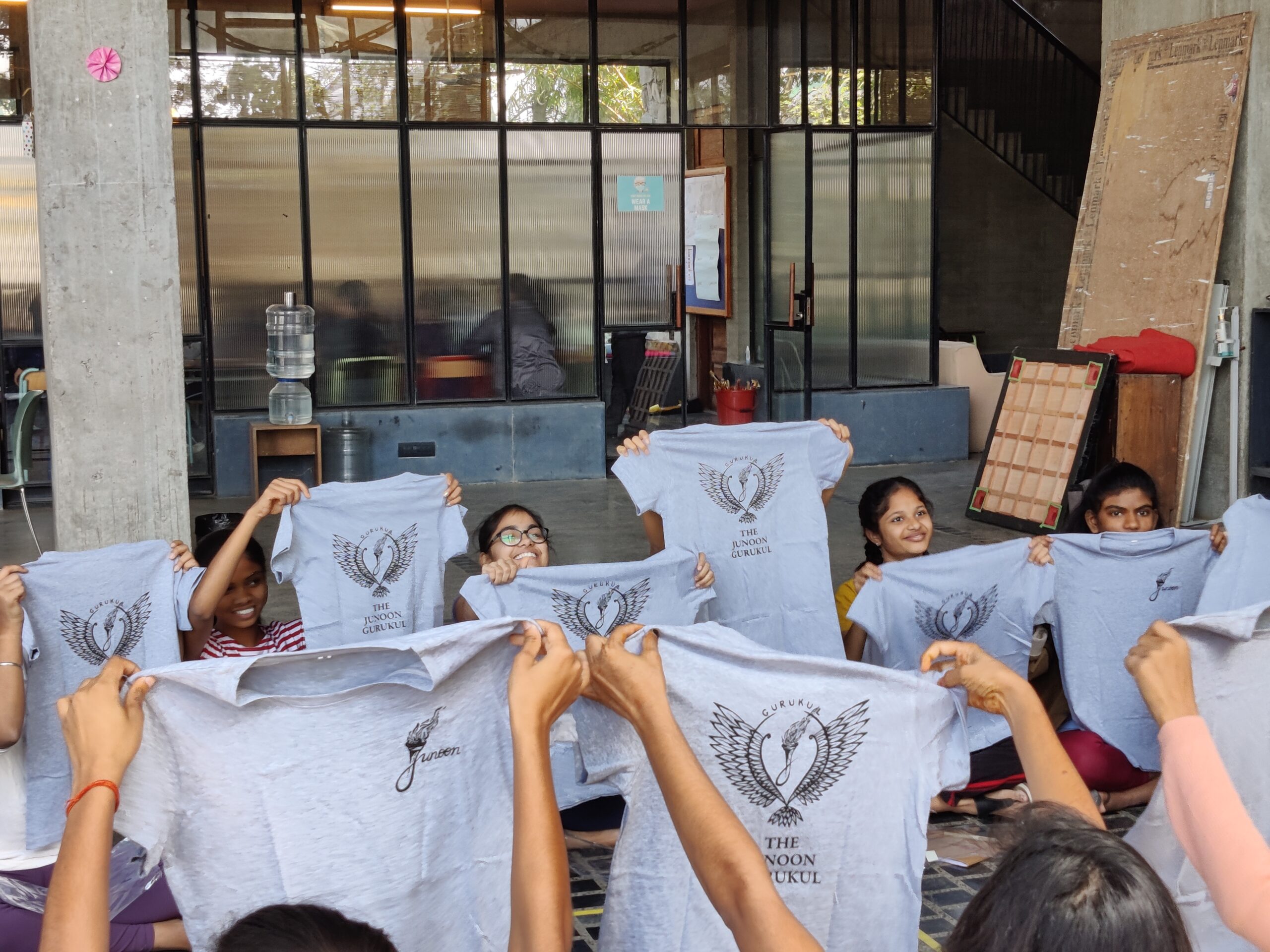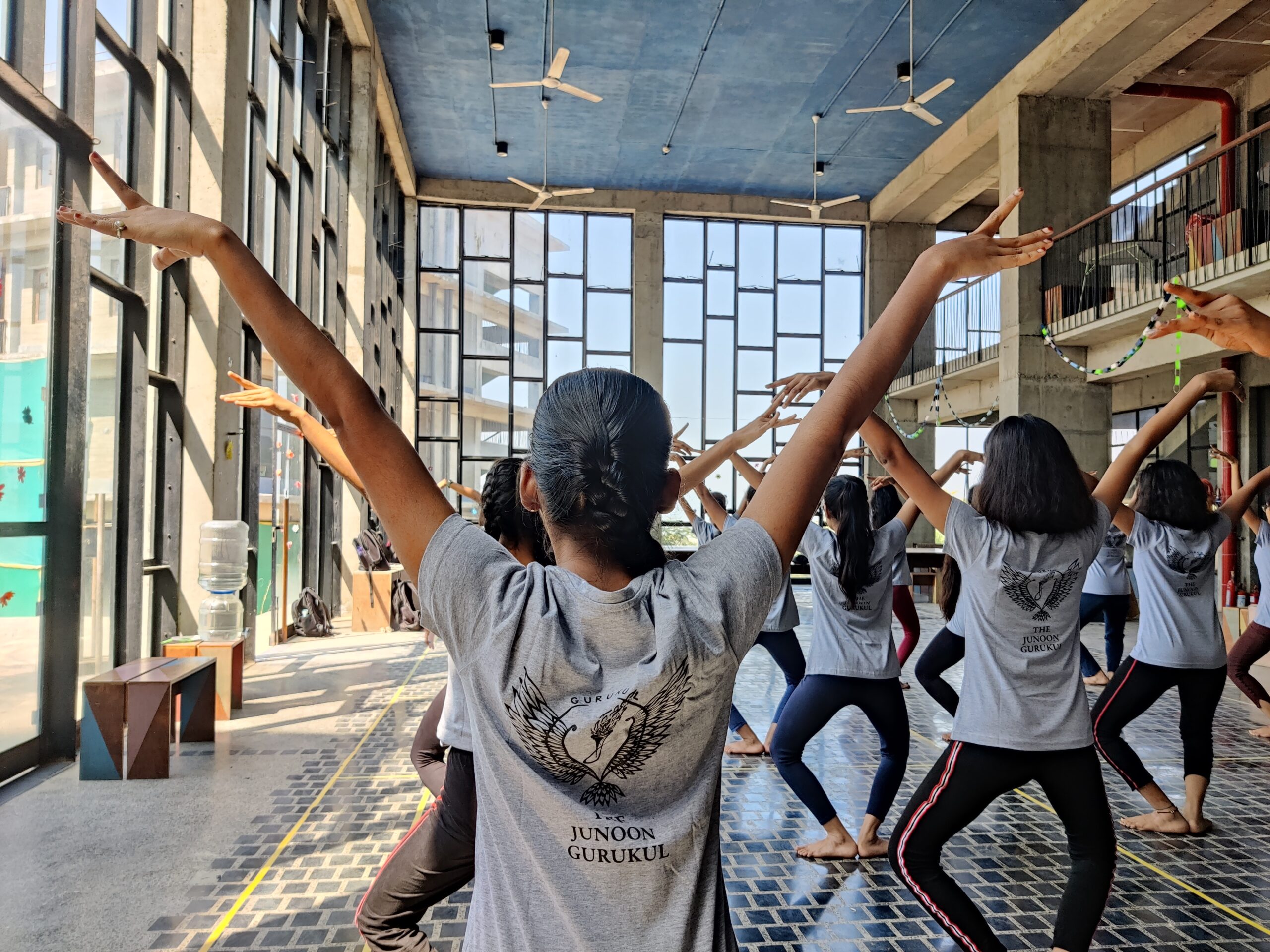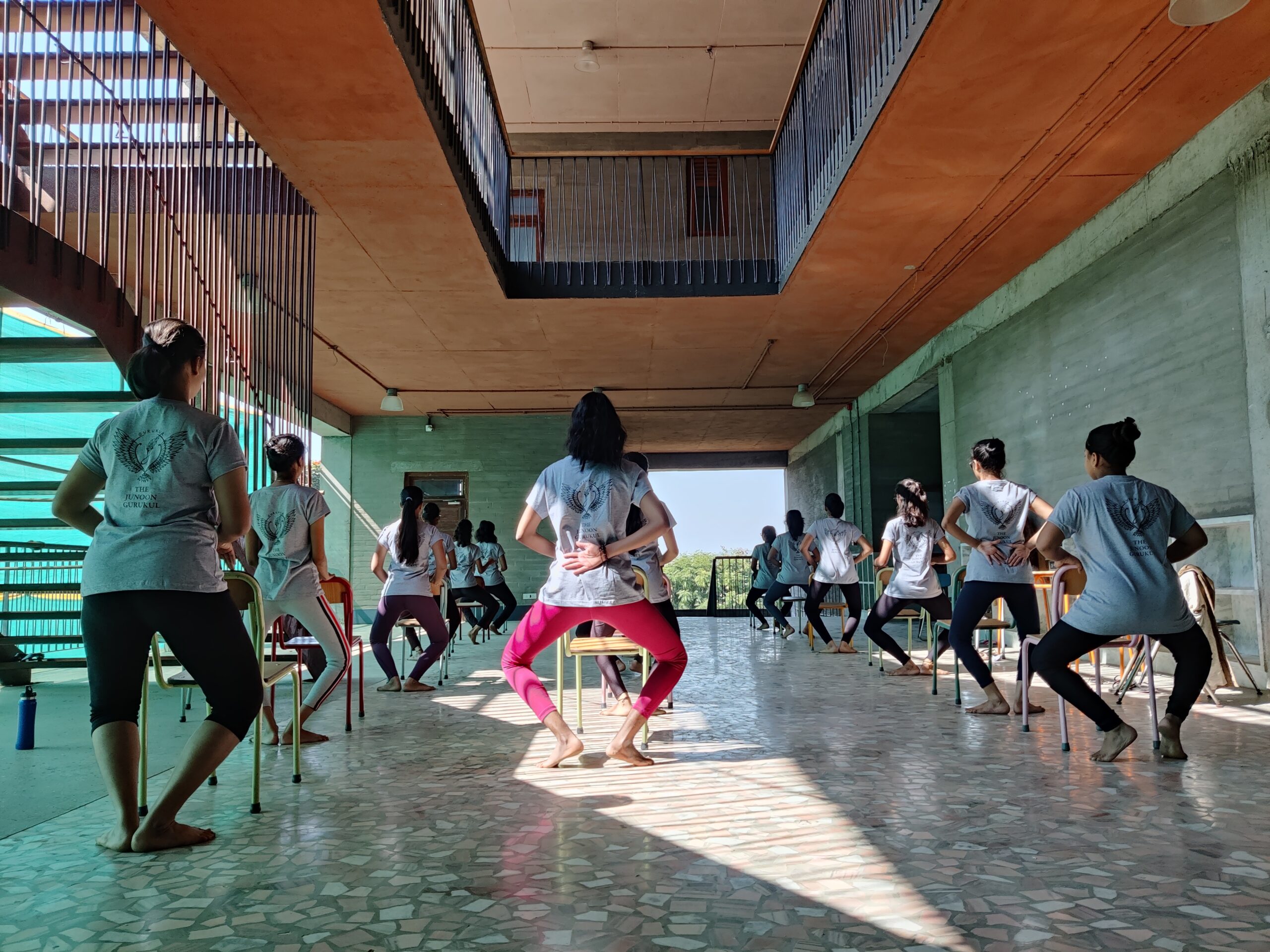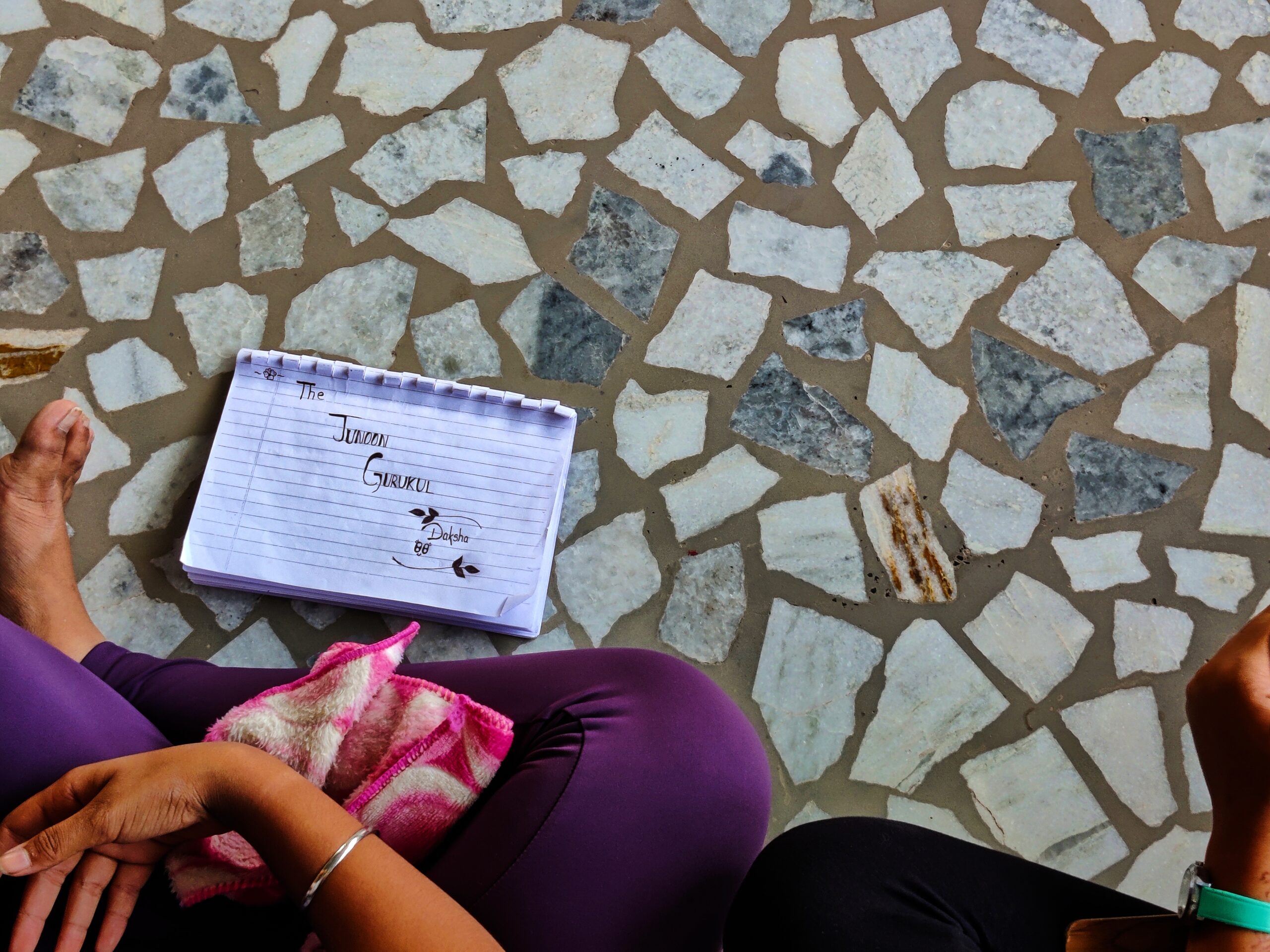Arriving at Avasara Academy

“Do you see the large grey buildings nearby? Yes, with the colourful blocks on top. That’s where we are. See you soon!”
Despite researching extensively and reading about the project, I did not know what to expect as I stood outside the gates of Avasara Academy. What would this project entail? What is the essence of The Junoon Gurukul? How does the academy lend support to this movement? With questions flooding my mind and heightened curiosity, I set foot into the academy.
Avasara Academy, a secondary girls’ school and leadership academy is tucked in the hilly regions of Pune’s Bavdhan suburb. The moment one sets foot on campus, they are whisked into an entirely different world. A blooming tree greets each visitor, providing shade and respite from the scorching sun. Pebble-filled paths lead one to large, grey concrete structures, with a dash of colour on top. The concrete spaces are contrasted with swaying trees and plants that occupy extensive spaces throughout the campus. The buildings are airy, and vast, with tempered glass replacing concrete walls – drenching each nook and cranny with sunlight.
The academy was founded in 2015 to bring together girls across India, providing access to good education, exposure, and leadership opportunities. With a dedicated financial assistance program, Avasara Academy fuels the ambitions of girls coming from underprivileged backgrounds.
The campus is a canvas for the diverse minds that call the academy their home. Bright decorations adorning walls and windows, posters that display powerful messages, and the academy’s very own student-led Bulletin.
“Krishna! Welcome! You finally made it.” my reverie was broken by a greeting, followed by a warm smile. It was time. The Junoon Gurukul, here I come!
Bringing The Junoon Gurukul to Life

Mythili
The warm smile belonged to Mythili Zatakia; founder and chief showrunner of The Junoon Gurukul. She donned a grey t-shirt and yoga pants – one of her signature styles. Upon closer viewing, I realized that the t-shirt bore The Junoon Gurukul logo – a fiery and passionate representation of the community, the movement, and the Gurukul itself.
Mythili’s passion for her art is evident. Trained in the classical dance forms of Bharata Natyam and Ballet – Mythili, like many dancers, finds solace and meditation in dance.
While teaching her shishyas, Mythili’s razor-sharp gaze wanders from one girl to another, through each mudra, and each movement. “I tell the girls often,” she laughed, “of how my gurus watched over me with hawk eyes. I used to mess up a lot.”
The intensity and demand of her lessons may have been why Mythili halted her practice for a while, she admitted.
“Yes, I stopped practicing Bharata Natyam at a certain point” – a rather unconventional decision for classical dancers. However, she later realised just how much she missed it and eventually picked up from where she left off.
“This time, learning Bharata Natyam was my choice,” she stated, describing how that choice propelled her to commit to her art. What possibly drew her back to classical dance was the realization of Bharata Natyam’s impact. And how it builds a significantly strong foundation for a dancer, physically, mentally and emotionally.
Pursuing classical dance, Mythili became a part of something much bigger than herself. An art that is so challenging yet rewarding, so rigorous yet equally soothing, dating back thousands of years, yet relevant through the tests of time.
In solitude, when Mythili dances for nobody but herself, her movements and expressions reflect a unique symphony. A symphony of utmost concentration, serenity, meditation, reflection, and the relentless pursuit of perfection.
Ms Maneesha
Ms Maneesha’s presence during The Junoon Gurukul sessions is that of a wise, old guru. She sits silently – observing the session, the shishyas and the activities. Now and then, she contributes her knowledge about a certain topic.
The Director of Student Life at Avasara Academy, Ms Maneesha goes the extra mile to enrich the lives of the Avasara girls in the form of extracurricular activities. When she first met Mythili, Ms Maneesha gauged her passion for dance and culture. But what impacted her the most was Mythili’s knowledge of Indian heritage and culture. This paved the path for The Junoon Gurukul sessions at Avasara Academy.
“Somehow our students and the younger generation, across the country, are not connected with what is Indian anymore.” Ms Maneesha voiced. “As Mythili says, this (The Junoon Gurukul) is just dipping a foot into this. But if we can manage to make the younger generation aware of this, and get them interested, that would be an accomplishment for me.”
Ms Rajvi
Ms Rajvi, along with her colleagues, had envisioned the academy as a centre for the arts and culture, which came in myriad forms. Meditation, classical music and dance; Ms Rajvi envisioned activities fuelled by the Arts for the girls who would be attending the academy.
As the Development Manager at Avasara Academy, Ms Rajvi also connected with Mythili over The Junoon Gurukul. The interconnectedness of culture, Indian history, religion and various other components posed an exciting opportunity.
“We (Ms Rajvi and her colleagues) talked about how this could eventually become a significant part of the curriculum. That’s what we want to do.” She recounted, confessing, “Will we be able to achieve it? I don’t know. Do we want to make a strong effort towards it? Absolutely, yes.”
Ms Rajvi also joins the Junoon Gurukul sessions on occasion, engaging in lively banter with Mythili and capturing some captivating shots for The Junoon Gurukul’s Instagram handle. She is deeply appreciative of how the sessions have brought together girls from diverse backgrounds, ages and cities – building a community around dance and the arts.
The Girls in Grey

It was a particularly special day at The Junoon Gurukul. As Mythili carried a curious cardboard box to the Oberoi Hall, she mentioned something about t-shirts. The girls of The Junoon Gurukul were about to don their very own Junoon t-shirts, what an exciting moment!
The Junoon Gurukul batch at Avasara Academy comprised 22 girls, who were selected after an intense audition. It was a melting pot of young, vivacious learners who come from an array of grades, backgrounds and cities. Their energy was infectious, their aspirations were inspiring. One of the girls professed her love for economics, while another one discussed her interest in neurobiology. Some of the girls are en route to figuring out their future plans.
“It’s alright,” advised Mythili, “You’re young and have plenty of time. You will figure it out.”
The passing of such nuggets of wisdom is common during The Junoon Gurukul sessions. A particular nugget from Mythili remains ingrained in my mind.
“Do not look at the size labels and let them affect your self-esteem. I have selected the t-shirt sizes according to your height, understood girls? I want you to be as comfortable as possible while dancing and moving, so do not look at those labels! If you’re feeling uncomfortable, let me know.”
The relationship between guru and shishyas was an interesting one – as the girls held Mythili in the highest regard. But an air of playfulness and comfort consistently radiated from the group, as Mythili was a guru, mentor friend and elder sister to all of them.
When questioned about Mythili and The Junoon Gurukul, the girls were bursting with inputs, anecdotes and opinions.
“At the start, it was very tiring. But Ms Mythili’s vibe is amazing, she is very friendly.”
“She motivated us throughout. Even for studies. She would tell us to focus on our studies before the dance.”
“She used to be very busy but she would write big, big letters to us! We also write letters to her.”
The letters which can be accessed on The Junoon Gurukul’s website, are thoroughly engaging reads. It was a delight to observe how a relatively ‘old-school’ practice was revived and seamlessly inculcated within the shishyas. For several girls, the letters are reflections – upon the sessions, a particular movement, a significant moment, and much more.
A candid letter by one of the girls mentioned how a particular week was a “total disaster”, and how she didn’t feel like doing anything. She signed off by saying that while she did not practice her dance moves, she read up and watched informative videos. It was uplifting to see how the girls in grey did not simply label The Junoon Gurukul sessions as another dance class. Instead, they upheld the promise of being active learners who sought knowledge wherever they went.
“I don’t like classical dance,” confessed one of the students to my amusement. “I do hip-hop and freestyle, so this was a completely new experience. But this was not just about dance,” she explained. “We got to know more about art and transforming things – it is like a bridge from one point of view to another. So learning about art was amazing, but classical dance is still a struggle for me.” Her statement invited chuckles from her friends.
However, her thoughts are not isolated. Like every art form, classical dance demands much from an artiste. Understanding the nuances of either Ballet or Bharata Natyam at a young age may be tricky, as it was with Mythili during her initial training. Despite the erratic relationship with classical dance, our hip-hop-loving girl in grey understands that dance is but one element of The Junoon Gurukul – and there are diverse elements she can engage with and learn. It is holistic learning in its truest and purest sense.
“I always wanted to learn classical dance but I never got the opportunity to learn, and I still remember the introduction session we had with Ms Mythili. I was amazed. I signed up for auditions at the last minute and got selected.” shared another girl in grey. “It is not just about dance, it is about our body, flexibility, strength and endurance. Coming from a sports background, that appealed to me.”
Several girls discussed the auditions at length – as if it was a rite of passage for them. With some batches comprising over 60 girls, the competition was cutthroat. Along with certain physical and foundational skills, the girls were selected for their willingness to walk the walk. They were aware of the challenges that lay ahead of them. Each pose, each stance would involve colossal efforts. Some days would be tougher than the rest. But that did not deter them from transforming each session into a takeaway that would follow them outside classroom walls.
The distinctness of each girl is communicated through dance. I have always believed that each dancer brings something special to any dance form they train for, be it a subtle expression, an ada, or how they carry themselves. I wasn’t wrong. Each girl in grey brought her zing to the sessions and retained her individuality while learning and mastering each movement with her 21 batchmates.
The Junoon Gurukul at Avasara Academy

Words that hold infinite power, passion and meaning – The Junoon Gurukul.
“Junoon” comes from Urdu, translating to “passion”, “madness”, and “intensity”. Junoon encapsulates a spectrum of emotions that inspire, stir, drive and motivate even the most reserved people.
“Gurukul” finds its root in ancient India, an elaborate and holistic education system that was ahead of its time. Education transcended the walls of a classroom, as nature and the great outdoors provided a safe and nurturing space for shishyas to flourish. At Gurukul, students lent an equal hand in everything, be it preparing meals, keeping the surroundings tidy, or mentoring the younger ones.
The convergence of these words can only result in a powerful yet grounded, fierce yet meditative, and modern yet rooted movement. This is what Mythili set out to implement.
And thus, The Junoon Gurukul transformed into reality. From an outreach program in the village of Dhasa, Gujarat, to establishing and implementing The Junoon Gurukul program at Avasara Academy, it has been an arduous yet fulfilling journey. Each workshop and activity of The Junoon Gurukul derives inspiration from the motto of Junoon, “To enable an awareness and diffusion of classical dance”. While classical dance is at the epicentre of this highly immersive arts program, it holistically addresses and provides insights into the multiple supporting classical arts. Shishyas who choose to partake in the sessions receive a wholesome learning experience – from classical and contemporary dance to everything in between.
I observed the same throughout Junoon Gurukul’s sessions. Each mudra, each movement, and each expression was elevated with the exploration and discussion of Indian history, anthropology, the arts and mythology. The exchange of knowledge was mutual, as our girls in grey freely shared their thoughts and interpretations of the subject in discussion.
“They are very intelligent children,” pronounced Mythili. “You can’t just give them a concept and tell them to take it as the truth. We don’t want that either.”
What struck me is the attempt to bring a balance between reconnecting with one’s roots without remaining stagnant. The girls are familiarized with their roots and culture but are encouraged to speak up and voice their thoughts. This cultivates growth while imbibing a sense of familiarity, relatability and belonging to the matter being taught in a session.
Ballet and Bharata Natyam

When it’s time to dance, the session oscillates between two classical dance forms.
Bharata Natyam is an ancient dance form that originates in Tamil Nadu and is an expression of mythological themes and spiritual ideas. Ballet, a ‘Western’ classical dance form that originated during the Italian Renaissance, conveys stories through music, contemporary movement and emotion. Apart from the depth and rich history the two dance forms hold, there is the added benefit of physical adeptness.
“Imagine a lethal combination of classical Ballet and Bharata Natyam. If you have kids dancing both dance forms, both support and strengthen one another. I think the students’ foundation will not only be on par with but beyond what the world has.” clarified Mythili.
“When you’re learning both dance forms together,” added Ms Maneesha, “I’ve noticed some foundational similarities in the movement, and yet there are very fine, detailed differences. It helps one understand, as a performer and learner, that things can be similar yet different.”
Similar yet different – a vital aspect of both dance forms. Ms Maneesha’s thoughts were reiterated by Mythili, who added how our girls in grey shape their foundation with similar techniques and nuances from both dance forms. At first glance, Bharata Natyam and Ballet appear to be poles apart – but they share subtle similarities that are gracefully adopted by the girls. Mythili also stated how The Junoon Gurukul contemporizes both dance forms to showcase the long-standing relevance they hold.
Two exceptional dance forms, two contrasting cultures, and the intertwining of classic with contemporary. And yet, with each session, our girls in grey learnt the underlying similarities shared by both dance forms. As the floor reverberated with the steady sound of thumping feet, beauty emerged in each adavu and plié. The balance maintained while attempting an asana for Bharata Natyam lends strength to an arabesque. The precision required in a port de bras in Ballet lends perfection to a mudra.
As Mythili imparted the delicacies and complexities of both dance forms, she ensured that her shishyas practiced each movement physically.
“If a question is asked, I always think – can I demonstrate the answer?” she spoke. Demonstrative learning allows Mythili to teach holistically. Theoretical concepts are reinforced with practical examples – whether it is demonstrating a technique or encouraging the girls to model a movement. I realized how a safe space does wonders for the girls as they emulate, learn, model, and even mess up, but always get back on their feet to learn again.
These lessons remain with the girls long after the session is over. One can observe a straighter spine, a more elegant gait, and a fascinating rhythm in which the girls carry themselves. That is perhaps the most compelling aspect of learning classical dance forms. The impact they leave on people is often more profound than one could comprehend.
Art Fuels Social Causes and Change

“Art in its highest form is art that serves and instructs society and human development.”
– Harry Belafonte
Art and social causes share a long history. Be it political commentary, gender inequalities, or sociocultural issues – art has consistently been at the forefront of social causes. From choreographies representing the African-American community during the 2020 Black Lives Matter movement to the Live Aid concert in 1985 for famine relief in African nations.
At The Junoon Gurukul, our girls in grey are educated on the capacity of art to create waves and social change. But first and foremost, the change arises from within. These girls are a testament to the kind of physical, mental and emotional changes art brings about. Be it mastering a dance set, orating confidently in the presence of others, feeling comfortable in one’s skin or simply attaining inner peace – The Junoon Gurukul strives to instil positive change within the girls.
This itself is a manifestation of social change. The Junoon Gurukul upholds its promise to create a solid foundation for youngsters who wish to learn classical dance. If one went back in time, this was a pipe dream. Having progressed from eras that restricted the fine arts to a hegemonic set of genders, classes, religions, castes and backgrounds, The Junoon Gurukul has shattered the shackles to emerge as a beacon of change. It has made the arts accessible to all.
With accessibility comes knowledge. Knowledge stimulates growth. Growth gives rise to confidence, thus fuelling freedom. I can heartily agree that each student of The Junoon Gurukul has and will be free; to dance, express, explore and make an impact.
Our bright and talented girls in grey will grow to understand social change, perhaps even conceiving newer avenues to promote social change through the arts. And it will truly be a moment of pride for the women behind The Junoon Gurukul, knowing that somewhere along the way, their vision was the first step towards inspiring change.
This incredibly heartfelt, comprehensive and beautiful read is written by Krishna Barot, a young, fiercely talented and sensitive writer. Few emerging documentarians could have chronicled this journey like she has. It takes a huge heart to write for Art and we’re so grateful for hers. If you are engaged with us on social media, you will be able to access the brilliant audio-visual content, captured and put together by her, to complement and best illustrate her words.
Krishna, continue to change the world with your words, your words for Art and therefore, your Art.
DISCLAIMER: The content on this website is merely an opinion and not intended to malign any religion, ethnic group, organisation, company or individual. Nothing contained herein shall to any extent substitute for the independent investigations and sound judgment of the reader. While we have made every attempt to ensure the accuracy and completeness of the content contained herein, no warranty or guarantee, express or implied, is given with respect to the same. The SHOUT! Network is neither liable nor responsible to any person or entity for any errors or omissions, or for any offense caused from such content.
In addition to the above, thoughts and opinions change from time to time… we consider this a necessary consequence of having an open mind. This website is intended to provide a semi-permanent point in time snapshot and manifestation of the various topics running around our brains, and as such any thoughts and opinions expressed within out-of-date posts may not be the same, or even similar, to those we may hold today.
Feel free to challenge us, disagree with us, or tell us we’re completely nuts in the comments section of each piece. The SHOUT! Network reserves the right to delete any comment for any reason whatsoever (abusive, profane, rude, or anonymous comments) – but do SHOUT! with us, if you will.














